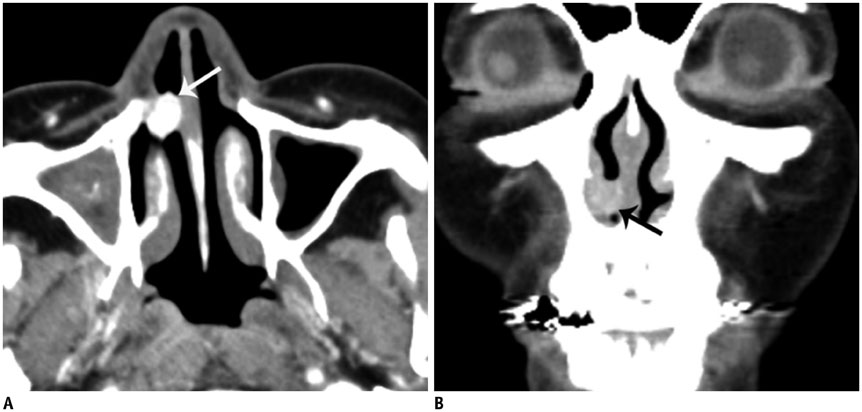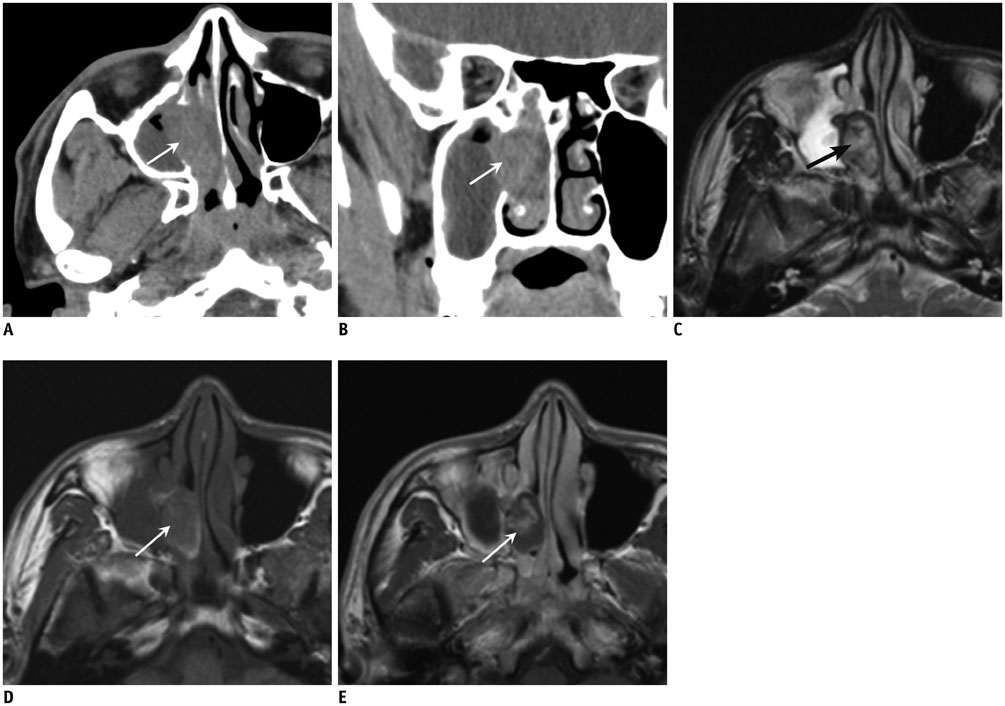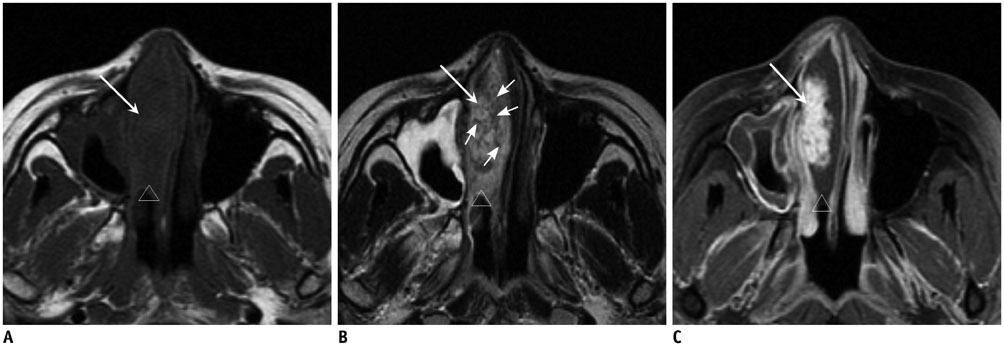Korean J Radiol.
2015 Jun;16(3):566-574. 10.3348/kjr.2015.16.3.566.
Computed Tomography and Magnetic Resonance Imaging Findings of Nasal Cavity Hemangiomas According to Histological Type
- Affiliations
-
- 1Department of Radiology, Inha University School of Medicine, Incheon 400-711, Korea. swpark8802@gmail.com
- 2Department of Radiology, Seoul National University College of Medicine, Seoul 110-744, Korea.
- 3Department of Radiology, Boramae Medical Center, Seoul 156-707, Korea.
- 4Department of Otolaryngology-Head & Neck Surgery, Inha University School of Medicine, Incheon 400-711, Korea.
- 5Department of Radiology, Inha University Hospital, Incheon 400-711, Korea.
- KMID: 2155526
- DOI: http://doi.org/10.3348/kjr.2015.16.3.566
Abstract
OBJECTIVE
To compare computed tomography (CT) and magnetic resonance imaging (MRI) findings between two histological types of nasal hemangiomas (cavernous hemangioma and capillary or lobular capillary hemangioma).
MATERIALS AND METHODS
CT (n = 20; six pre-contrast; 20 post-enhancement) and MRI (n = 7) images from 23 patients (16 men and seven women; mean age, 43 years; range, 13-73 years) with a pathologically diagnosed nasal cavity hemangioma (17 capillary and lobular capillary hemangiomas and six cavernous hemangiomas) were reviewed, focusing on lesion location, size, origin, contour, enhancement pattern, attenuation or signal intensity (SI), and bony changes.
RESULTS
The 17 capillary and lobular hemangiomas averaged 13 mm (range, 4-37 mm) in size, and most (n = 13) were round. Fourteen capillary hemangiomas had marked or moderate early phase enhancement on CT, which dissipated during the delayed phase. Four capillary hemangiomas on MRI showed marked enhancement. Bony changes were usually not seen on CT or MRI (seen on five cases, 29.4%). Half of the lesions (2/4) had low SI on T1-weighted MRI images and heterogeneously high SI with signal voids on T2-weighted images. The six cavernous hemangiomas were larger than the capillary type (mean, 20.5 mm; range, 10-39 mm) and most had lobulating contours (n = 4), with characteristic enhancement patterns (three centripetal and three multifocal nodular), bony remodeling (n = 4, 66.7%), and mild to moderate heterogeneous enhancement during the early and delayed phases.
CONCLUSION
CT and MRI findings are different between the two histological types of nasal hemangiomas, particularly in the enhancement pattern and size, which can assist in preoperative diagnosis and planning of surgical tumor excision.
Keyword
MeSH Terms
Figure
Cited by 2 articles
-
Extranasopharyngeal Angiofibroma of the Nasal Septum: A Case Report
Gyoung-Eun Lee, Tae Gyu Kim, Kyung-Eun Bae, Kyoung Rai Cho, Jung Heob Sohn, Bo Young Kim, Hyun-jung Kim, Guhyun Kang
J Korean Soc Radiol. 2019;80(4):750-755. doi: 10.3348/jksr.2019.80.4.750.A Case of 2-Month-Old Infant with Lobular Capillary Hemangioma
Yong Seok Kang, Young Kang, Doo Hee Han
J Rhinol. 2017;24(2):127-131. doi: 10.18787/jr.2017.24.2.127.
Reference
-
1. Dillon WP, Som PM, Rosenau W. Hemangioma of the nasal vault: MR and CT features. Radiology. 1991; 180:761–765.2. Iwata N, Hattori K, Nakagawa T, Tsujimura T. Hemangioma of the nasal cavity: a clinicopathologic study. Auris Nasus Larynx. 2002; 29:335–339.3. Osborn DA. Haemangiomas of the nose. J Laryngol Otol. 1959; 73:174–179.4. Kim HJ, Kim JH, Kim JH, Hwang EG. Bone erosion caused by sinonasal cavernous hemangioma: CT findings in two patients. AJNR Am J Neuroradiol. 1995; 16:1176–1178.5. Lee DG, Lee SK, Chang HW, Kim JY, Lee HJ, Lee SM, et al. CT features of lobular capillary hemangioma of the nasal cavity. AJNR Am J Neuroradiol. 2010; 31:749–754.6. Yang BT, Li SP, Wang YZ, Dong JY, Wang ZC. Routine and dynamic MR imaging study of lobular capillary hemangioma of the nasal cavity with comparison to inverting papilloma. AJNR Am J Neuroradiol. 2013; 34:2202–2207.7. Feingold M. Picture of the month. Hemangioma and lymphangioma of the nose. Am J Dis Child. 1985; 139:319–332.8. Batsakis JG, Rice DH. The pathology of head and neck tumors: vasoformative tumors, part 9A. Head Neck Surg. 1981; 3:231–239.9. Jones JE, Nguyen A, Tabaee A. Pyogenic granuloma (pregnancy tumor) of the nasal cavity. A case report. J Reprod Med. 2000; 45:749–753.10. el-Sayed Y, al-Serhani A. Lobular capillary haemangioma (pyogenic granuloma) of the nose. J Laryngol Otol. 1997; 111:941–945.11. Ash JE, Old JW. Hemangiomas of the nasal septum. Trans Am Acad Ophthalmol Otolaryngol. 1950; 54:350–356.12. Bhattacharyya N, Wenokur RK, Goodman ML. Endoscopic excision of a giant pyogenic granuloma of the nasal cavity caused by nasal packing. Rhinology. 1997; 35:44–45.13. Lee HM, Lee SH, Hwang SJ. A giant pyogenic granuloma in the nasal cavity caused by nasal packing. Eur Arch Otorhinolaryngol. 2002; 259:231–233.14. Miller FR, D’Agostino MA, Schlack K. Lobular capillary hemangioma of the nasal cavity. Otolaryngol Head Neck Surg. 1999; 120:783–784.15. Lance E, Schatz C, Nach R, Thomas P. Pyogenic granuloma gravidarum of the nasal fossa: CT features. J Comput Assist Tomogr. 1992; 16:663–664.16. Berenguer B, Mulliken JB, Enjolras O, Boon LM, Wassef M, Josset P, et al. Rapidly involuting congenital hemangioma: clinical and histopathologic features. Pediatr Dev Pathol. 2003; 6:495–510.17. Dufour H, Fesselet J, Métellus P, Figarella-Branger D, Grisoli F. Cavernous hemangioma of the sphenoid sinus: case report and review of the literature. Surg Neurol. 2001; 55:169–173.18. Vargas MC, Castillo M. Sinonasal cavernous haemangioma: a case report. Dentomaxillofac Radiol. 2012; 41:340–341.19. Kim EY, Kim HJ, Chung SK, Dhong HJ, Kim HY, Yim YJ, et al. Sinonasal organized hematoma: CT and MR imaging findings. AJNR Am J Neuroradiol. 2008; 29:1204–1208.20. Wang YZ, Yang BT, Wang ZC, Song L, Xian JF. MR evaluation of sinonasal angiomatous polyp. AJNR Am J Neuroradiol. 2012; 33:767–772.21. Yagisawa M, Ishitoya J, Tsukuda M. Hematoma-like mass of the maxillary sinus. Acta Otolaryngol. 2006; 126:277–281.22. Song CE, Cho JH, Kim SY, Kim SW, Kim BG, Kang JM. Endoscopic resection of haemangiomas in the sinonasal cavity. J Laryngol Otol. 2009; 123:868–872.
- Full Text Links
- Actions
-
Cited
- CITED
-
- Close
- Share
- Similar articles
-
- Solitary Neurofibroma of the Nasal Cavity: Transnasal Endoscopic Excision
- A study on the comparision of various imaging methods for the staging of renal cell carcinoma
- A Case of Sinonasal Tearatocarcinosarcoma of Nasal Cavity
- Retained Bone Wax on CT at One Year after Dacryocystorhinostomy: A Case Report
- Hemangiomas with the Variable Manifestations on Breast Imaging: Three Case Reports




